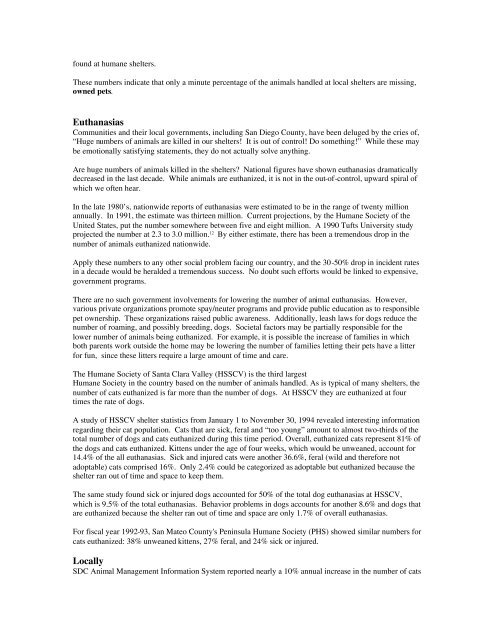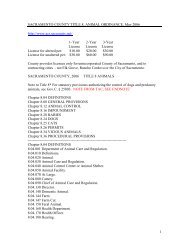San Diego County Survey and analysis of the pet population Karen ...
San Diego County Survey and analysis of the pet population Karen ...
San Diego County Survey and analysis of the pet population Karen ...
Create successful ePaper yourself
Turn your PDF publications into a flip-book with our unique Google optimized e-Paper software.
found at humane shelters.These numbers indicate that only a minute percentage <strong>of</strong> <strong>the</strong> animals h<strong>and</strong>led at local shelters are missing,owned <strong>pet</strong>s.EuthanasiasCommunities <strong>and</strong> <strong>the</strong>ir local governments, including <strong>San</strong> <strong>Diego</strong> <strong>County</strong>, have been deluged by <strong>the</strong> cries <strong>of</strong>,“Huge numbers <strong>of</strong> animals are killed in our shelters! It is out <strong>of</strong> control! Do something!” While <strong>the</strong>se maybe emotionally satisfying statements, <strong>the</strong>y do not actually solve anything.Are huge numbers <strong>of</strong> animals killed in <strong>the</strong> shelters? National figures have shown euthanasias dramaticallydecreased in <strong>the</strong> last decade. While animals are euthanized, it is not in <strong>the</strong> out-<strong>of</strong>-control, upward spiral <strong>of</strong>which we <strong>of</strong>ten hear.In <strong>the</strong> late 1980’s, nationwide reports <strong>of</strong> euthanasias were estimated to be in <strong>the</strong> range <strong>of</strong> twenty millionannually. In 1991, <strong>the</strong> estimate was thirteen million. Current projections, by <strong>the</strong> Humane Society <strong>of</strong> <strong>the</strong>United States, put <strong>the</strong> number somewhere between five <strong>and</strong> eight million. A 1990 Tufts University studyprojected <strong>the</strong> number at 2.3 to 3.0 million. 12 By ei<strong>the</strong>r estimate, <strong>the</strong>re has been a tremendous drop in <strong>the</strong>number <strong>of</strong> animals euthanized nationwide.Apply <strong>the</strong>se numbers to any o<strong>the</strong>r social problem facing our country, <strong>and</strong> <strong>the</strong> 30-50% drop in incident ratesin a decade would be heralded a tremendous success. No doubt such efforts would be linked to expensive,government programs.There are no such government involvements for lowering <strong>the</strong> number <strong>of</strong> animal euthanasias. However,various private organizations promote spay/neuter programs <strong>and</strong> provide public education as to responsible<strong>pet</strong> ownership. These organizations raised public awareness. Additionally, leash laws for dogs reduce <strong>the</strong>number <strong>of</strong> roaming, <strong>and</strong> possibly breeding, dogs. Societal factors may be partially responsible for <strong>the</strong>lower number <strong>of</strong> animals being euthanized. For example, it is possible <strong>the</strong> increase <strong>of</strong> families in whichboth parents work outside <strong>the</strong> home may be lowering <strong>the</strong> number <strong>of</strong> families letting <strong>the</strong>ir <strong>pet</strong>s have a litterfor fun, since <strong>the</strong>se litters require a large amount <strong>of</strong> time <strong>and</strong> care.The Humane Society <strong>of</strong> <strong>San</strong>ta Clara Valley (HSSCV) is <strong>the</strong> third largestHumane Society in <strong>the</strong> country based on <strong>the</strong> number <strong>of</strong> animals h<strong>and</strong>led. As is typical <strong>of</strong> many shelters, <strong>the</strong>number <strong>of</strong> cats euthanized is far more than <strong>the</strong> number <strong>of</strong> dogs. At HSSCV <strong>the</strong>y are euthanized at fourtimes <strong>the</strong> rate <strong>of</strong> dogs.A study <strong>of</strong> HSSCV shelter statistics from January 1 to November 30, 1994 revealed interesting informationregarding <strong>the</strong>ir cat <strong>population</strong>. Cats that are sick, feral <strong>and</strong> “too young” amount to almost two-thirds <strong>of</strong> <strong>the</strong>total number <strong>of</strong> dogs <strong>and</strong> cats euthanized during this time period. Overall, euthanized cats represent 81% <strong>of</strong><strong>the</strong> dogs <strong>and</strong> cats euthanized. Kittens under <strong>the</strong> age <strong>of</strong> four weeks, which would be unweaned, account for14.4% <strong>of</strong> <strong>the</strong> all euthanasias. Sick <strong>and</strong> injured cats were ano<strong>the</strong>r 36.6%, feral (wild <strong>and</strong> <strong>the</strong>refore notadoptable) cats comprised 16%. Only 2.4% could be categorized as adoptable but euthanized because <strong>the</strong>shelter ran out <strong>of</strong> time <strong>and</strong> space to keep <strong>the</strong>m.The same study found sick or injured dogs accounted for 50% <strong>of</strong> <strong>the</strong> total dog euthanasias at HSSCV,which is 9.5% <strong>of</strong> <strong>the</strong> total euthanasias. Behavior problems in dogs accounts for ano<strong>the</strong>r 8.6% <strong>and</strong> dogs thatare euthanized because <strong>the</strong> shelter ran out <strong>of</strong> time <strong>and</strong> space are only 1.7% <strong>of</strong> overall euthanasias.For fiscal year 1992-93, <strong>San</strong> Mateo <strong>County</strong>'s Peninsula Humane Society (PHS) showed similar numbers forcats euthanized: 38% unweaned kittens, 27% feral, <strong>and</strong> 24% sick or injured.LocallySDC Animal Management Information System reported nearly a 10% annual increase in <strong>the</strong> number <strong>of</strong> cats




